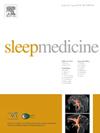Clinical tics and quality of life in children and adolescents with tic disorders: The mediating role of sleep
IF 3.8
2区 医学
Q1 CLINICAL NEUROLOGY
引用次数: 0
Abstract
Background
Sleep conditions are important in children and adolescents with tic disorders. Psychiatric symptoms and tic symptoms themselves can detrimentally affect the quality of life (QOL) in individuals with tic disorders. However, there is currently a lack of explicit research evidence elucidating the relationship between sleep and the QOL in individuals with tic disorders.
Methods
We assessed 150 children/adolescents aged 4–14 years old diagnosed with tic disorders. Participants' tic symptoms were evaluated using the Yale Global Tic Severity Scale (YGTSS), while their sleep conditions were assessed using the Children's Sleep Habits Questionnaire (CSHQ), and quality of life was measured using the Gilles de la Tourette Syndrome-Quality of Life Scale (GTS-QOL), all utilizing standardized measurement instruments. Detailed statistical descriptions, correlation analyses, and mediation analyses of the data were performed.
Results
We observed significant correlations among tic symptoms, sleep, and quality of life. Then, we confirmed the mediating role of sleep in the relationship between tic symptoms and quality of life (β = .591, 95%CI: .252–1.007). We also found that among different sleep variables, particularly bedtime resistance (β = .088, 95 % CI: .003–.260), played a significant mediating role.
Conclusions
Sleep was found to be a significantly mediator between tic symptoms and quality of life across various domains, especially bedtime resistance played an important mediating role. This indicates that assessment and management of sleep conditions in children/adolescents with tic disorders are important. These findings provide potentially valuable insights into the clinical evaluation of children and adolescents with tic disorders and the potential improvement of their quality of life in the future.
患有抽搐症的儿童和青少年的临床抽搐和生活质量:睡眠的中介作用
背景睡眠状况对患有抽搐症的儿童和青少年非常重要。精神症状和抽搐症状本身会对抽搐症患者的生活质量(QOL)产生不利影响。然而,目前还缺乏明确的研究证据来阐明抽搐症患者的睡眠与 QOL 之间的关系。方法我们对 150 名被诊断患有抽搐症的 4-14 岁儿童/青少年进行了评估。我们使用耶鲁全球抽搐严重程度量表(YGTSS)评估了参与者的抽搐症状,使用儿童睡眠习惯问卷(CSHQ)评估了他们的睡眠状况,使用吉勒-德拉图雷特综合征生活质量量表(GTS-QOL)测量了他们的生活质量。结果我们观察到抽动症状、睡眠和生活质量之间存在显著的相关性。然后,我们证实了睡眠在抽搐症状和生活质量之间的中介作用(β = .591,95%CI:.252-1.007)。我们还发现,在不同的睡眠变量中,尤其是就寝阻力(β = .088,95 % CI:.003-.260)起着重要的中介作用。结论研究发现,睡眠在抽搐症状和生活质量之间的各个领域都起着重要的中介作用,尤其是就寝阻力起着重要的中介作用。这表明,对患有抽搐症的儿童/青少年的睡眠状况进行评估和管理非常重要。这些发现为抽搐症儿童和青少年的临床评估以及未来改善他们的生活质量提供了潜在的宝贵见解。
本文章由计算机程序翻译,如有差异,请以英文原文为准。
求助全文
约1分钟内获得全文
求助全文
来源期刊

Sleep medicine
医学-临床神经学
CiteScore
8.40
自引率
6.20%
发文量
1060
审稿时长
49 days
期刊介绍:
Sleep Medicine aims to be a journal no one involved in clinical sleep medicine can do without.
A journal primarily focussing on the human aspects of sleep, integrating the various disciplines that are involved in sleep medicine: neurology, clinical neurophysiology, internal medicine (particularly pulmonology and cardiology), psychology, psychiatry, sleep technology, pediatrics, neurosurgery, otorhinolaryngology, and dentistry.
The journal publishes the following types of articles: Reviews (also intended as a way to bridge the gap between basic sleep research and clinical relevance); Original Research Articles; Full-length articles; Brief communications; Controversies; Case reports; Letters to the Editor; Journal search and commentaries; Book reviews; Meeting announcements; Listing of relevant organisations plus web sites.
 求助内容:
求助内容: 应助结果提醒方式:
应助结果提醒方式:


